Featured Application
This article describes the use of Raster Stereography in the monitoring of the changes in spinal biomechanics. The measurement results show the effect of sitting on different types of office chair, on changes in the curvature of the spine.
Abstract
The current development trend of the operational activities indicates an increase in occupations which last for a few generations and whose primary position is the activity in the sitting position. This trend is directly connected with the technological progress and development of the society within Industry 4.0. However, the workplaces intended for sitting occupations that are designed according to the current standards are unsuitable from several perspectives. The long-term sitting activities at most actual workplaces cause an accumulation of the static load. For this reason, the article deals with dynamizing the activities in the sitting position. The presented research is based on utilizing the knowledge of the sitting posture dynamics and on the information acquired through diagnostics based on the Raster Stereography as an innovative method based on modelling a natural human spin. The article brings the first research results, which points out the fact that probably not all types of dynamic sitting that are nowadays preferred are suitable for long-term working.
1. Introduction
Moretti et al. recently published the study, which concentrated on observing the influence of the home office on productivity, work stress, and musculoskeletal problems in the case of employees working from home. Moreover, the acceleration of production, development of technologies or optimization of the workplace, and manufacturing processes force employees to carry out activities with minimal movement (see Figure 1). In the case of manufacturing activities, it is the strictly defined optimal working spaces and non-manufacturing activities which require the sitting working position. The modern human population ceases moving during working but also non-working times. The consequences of such a lifestyle have been well-known for several decades—obesity, cardiovascular illnesses or body posture disorders that indirectly or principally affect the population health [,,,]. Due to the above negative impact on a professional and personal level, it is required to study the dynamization of the work.
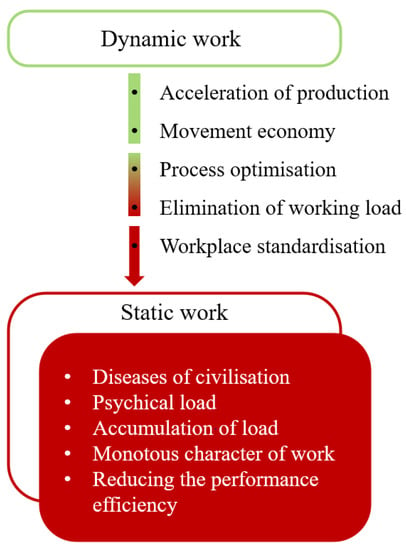
Figure 1.
Transformation of working activities—consequences [].
Much motion and physical loads during operation (e.g., handling with loads) are limited by national legislation, EU standards, ergonomic principles, and the principles of designing workplaces in the framework of Industrial Engineering. However, currently, things that affect manufacturing system performance efficiency are being changed [,].
If people carry out a minimal number of movements and all working devices are within their reach, they are maximally productive from the point of view of the movement economy and thus for a continuous production flow. The number of movements is proportional to the consumed time, and the consumed time is the entrance to work productivity. The productivity of work is one of the production effectiveness indicators that every industrial engineer wants to improve. On the one hand, reducing the amount and extent of the movements increases the productivity of work, but on the other hand, it reduces the employees’ movements. In the framework of the working activity, the same muscle groups are involved, leading to a long-term unidirectional load. At the same time, several muscle groups remain in a static position. The long-term work in the sitting position is a characteristic example [,,].
Dynamisation of Working Postures
The number of occupations requiring a sitting position is growing in all lines of business due to technological progress (for example, programmers, dispatchers, designers). Therefore, it is necessary to pay increased attention to dynamizing working postures in office workplaces. This dynamization can minimize the health problems caused by accumulating the static load. In this way, we eliminate the development of fatigue and health problems [,].
There are three ways to operate dynamically during work in the sitting position:
- A regular change in the main working position—changing the sitting position to the standing one. To ensure the continuity of the working activity, it is necessary to adapt the workplace in such a way that the employee will be able to carry out the operation also in the standing position. Such a change requires height-adjustable desks, and it is also necessary to enlarge the workplace’s floor area.
- The regular positioning through dynamic sitting—dynamic sitting ensures the elimination of the static load acting on a person during long-term sitting.
- The non-stationary workplace—the employee has no fixed workplace. Non-stationary workplaces are the trend of this millennium. They are typical of the so-called shared workplaces—the employee chooses the workplace that is free at that time. This means that after coming to the office, they take the seat which is most suitable for their activity. At the same time, these workplaces include sofas, armchairs and dayrooms where it is possible to work and rest. This type of workplace ensures dynamics just by the variety of the workplace.
However, it is necessary to say that this type of workplace need not guarantee the sufficient elimination of the static load’s impact. The ratio of the static and dynamic component of work for a subjective selection of the workplace is not checked and controlled objectively.
However, the work dynamization in the framework of the sitting occupations cannot be ensured to the necessary extent by the office equipment currently available. Therefore, it is necessary to create a workplace that will respond to the human body variability to ensure the necessary dynamics of the working positions, and at the same time, it will be sufficiently autonomous for reducing bad working habits.
Currently, there are investigations in the area of measuring the curvature of the spine in the sitting position. These investigations used the generally known medical methods for diagnostics—X-ray or MRI [,,,]. For our research, we used the equipment DIERS based on the principle of the Raster Stereography. One of the reasons why we utilized this tool is that the repeated scanning process does not create undesirable effects for human health [,,].
2. Materials and Methods
Currently, scientists enforce the idea of the dynamic sitting position on a dynamic chair or active changing of the working positions. We have been dealing with dynamizing the work from various points of view for a long time—from the studies realized by prediction and simulation up to utilizing the extended and virtual reality. In the framework of the progressive approaches, we are working with the DIERS equipment, whose technology combines computer modelling and Raster Stereography [,,,].
In the framework of investigating the sitting position, we have realized measurements that monitor the impact of the sitting position on various types of chairs on the curvature of the lower back. The measurements were carried out by the system DIERS formetric 4D used for the non-invasive scanning of the spine and subsequent diagnostics.
2.1. System DIERS
The system DIERS works on the basis of the video Raster Stereography (see Figure 2). It consists of a projector that projects a light grid consisting of horizontal lines on the person’s back. This grid is recorded by a scanning unit, and the software analyzes the curvature of the individual grid’s lines. Based on this curvature, the system creates a 3D image of the body surface [,,,,].
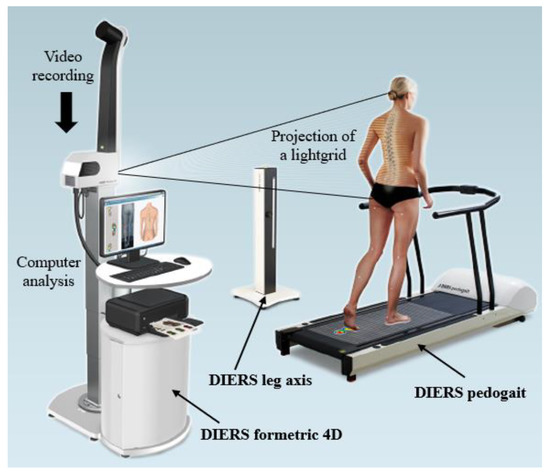
Figure 2.
System DIERS (own study based on: []).
The DIERS formetric 4D equipment is the basic module of the whole DIERS system. The system also consists of additional modules DIERS Leg Axis that realizes a fast and highly effective geometric analysis of the lower limbs and DIERS Pedogait that measures the distribution of the pressure on the foot during walking [,,,,].
The DIERS system provides complex information about the static of the whole body by a single measuring process without any negative impact on the human organism. Therefore, we decided to utilize this method. One measurement brings the necessary information in the following areas []:
- The spine curvature (both lateral and frontal);
- The vertebral rotation;
- The position of the pelvis;
- The muscle imbalance.
Thanks to the automatic detection of the anatomic points in cooperation with the correlation model that describes the dependence between the surface curvatures of the body and the orientation of the vertebrae (from Turner-Smith and Drerup), the system is able to show the real spine curvature and the position of the pelvis. The lower back holes and the ridge of the seventh cervical vertebra are the basic anatomic points.
2.2. System DIERS—Advantages and Disadvantages
The DIERS system is a non-radiative device. Only the light beams are projected on the human body. This is why people can be scanned repeatedly by this equipment, without any negative impact on their health. Both the pregnant women and children can be scanned too. This system is a diagnostic device; however, it can also serve for determining the therapy effects selected based on the developed or developing spine disorder.
The limited possibilities of scanning belong to the disadvantages of this system. Until now, the system has not been able to scan the cervical spine. Another disadvantage is that this equipment cannot scan obese people, tattooed people or those with an extensively haired back. A disadvantage of this equipment is also its size and the values of the minimal distance between the device and individual sensors that must be strictly held [].
2.3. Measurement Procedure
The laboratory measurements to detect the lower back spine curvature changes for various types of chairs were realized in the Lab of Ergonomics and Movements at the Department of Industrial Engineering of the University of Žilina in Žilina. Research respondents were introduced to the use of measurements for research purposes. No invasive methods were used during the study, and no substances were administered to the respondents in relation to the measurements. The measurements were realized as follows:
- Three types of chairs were used—the static (fixed) chair, dynamic chair and physiotherapeutic ball;
- The scanned volunteers (employees working in the predominantly sitting position, students);
- Fifty measurements for each type of chair, the reference measurement in the standing position.
Two types of posture were scanned for each chair—erect and relaxed sitting (see Figure 3). The erect sitting is characterized by the 90° angle that should be formed by the thighs with the trunk, the arms and forearms, the thighs and shanks and the lower leg with the foot. If the angles between these body parts do not form a 90° angle, it is a so-called relaxed sitting position [,,,,].
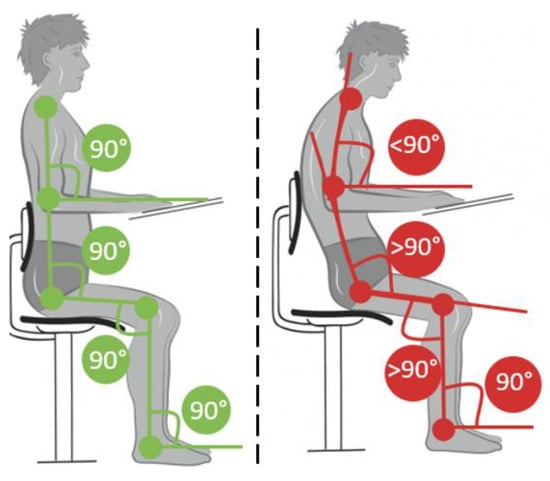
Figure 3.
Erect and relaxed sitting position.
During the testing procedure in the standing position, some of the participants showed deformations of the spine. For measurement were selected participants whose spine curvature and body posture could be considered adequate, from the point of view of their age, anatomy, and physiology. In this way, we tried to minimize the negative influence of acquiring the measurement data.
The bottom height of the chair seat was adjusted to 46 cm for the static chair and 48 cm for the dynamic chair. The difference in the participants’ chair adjustment was adapted by the different thickness of the upholstery used. The height adjustment of the physiotherapeutic ball was not possible; a ball with a standard diameter of 85 cm was used for the experiment. This diameter complies with usage for persons with a height of up to 185–195 cm. Due to the principle of scanning and acquiring data, the measurements were realized without using the spine support.
The scanning procedure was realized in a one-month period to eliminate the influence of fatigue on the body posture of the participants. Fifty scans of the spine for the erect standing position and fifty scans of the spine for the erect sitting position on a static chair and physiotherapeutic ball were carried out. Each measurement recorded the values of the kyphosis angle and the angle and depth of the lower back lordosis, as shown in Figure 4.
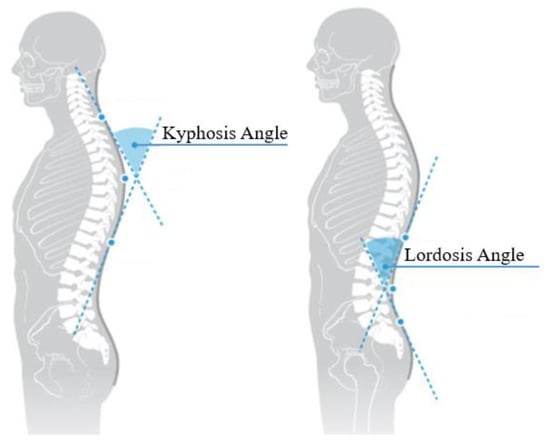
Figure 4.
The angles of the kyphosis and lower back lordosis [].
Figure 5, Figure 6, Figure 7 and Figure 8 show the measurements on individual types of chairs during the erect sitting position and the reference scanning in the standing position (male, 39 years old, height 182 cm and working in the office).
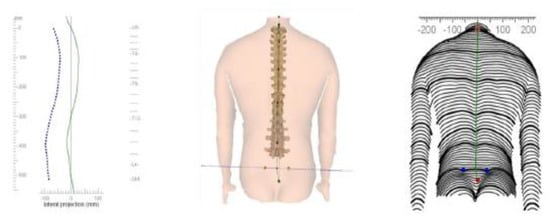
Figure 5.
Reference measurement in standing position.
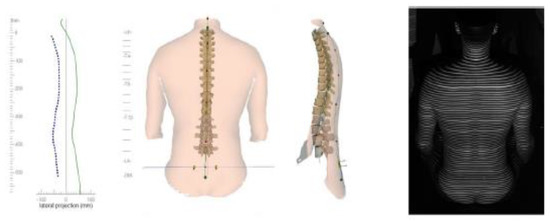
Figure 6.
Sitting position on a static chair.
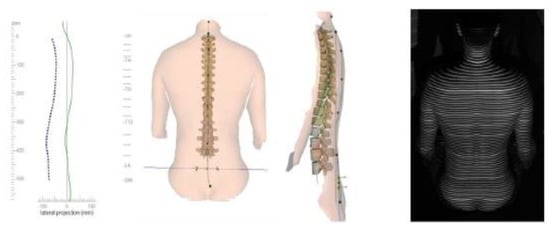
Figure 7.
Sitting position on a dynamic chair.
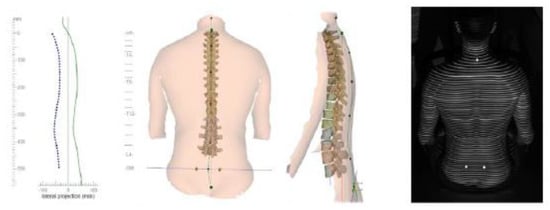
Figure 8.
Sitting position on a physiotherapeutic ball.
3. Results
Because the Slovak legislation determines erect sitting as the only acceptable working position, we analyzed only the measurement results for this type of sitting. The value range that the observed parameters achieved during 50 measurements of the reference scanning are depicted in Figure 9, Figure 10 and Figure 11.
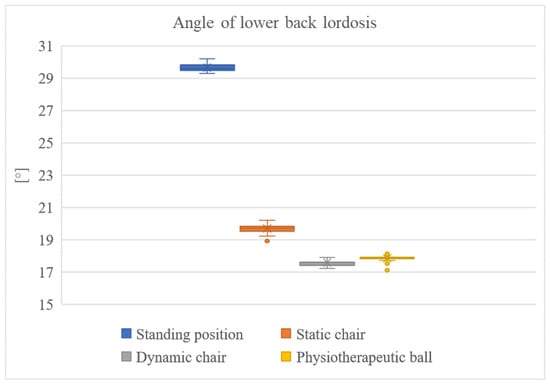
Figure 9.
Range of values of the observed body parameters.
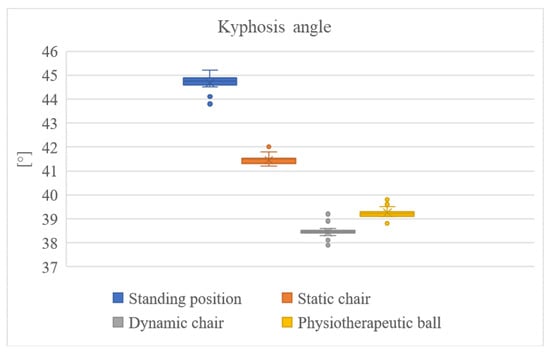
Figure 10.
Range of values of the followed body parameters.
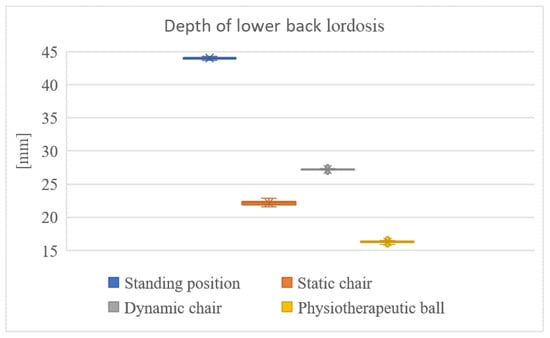
Figure 11.
Range of values of the followed body parameters.
The diagram in Figure 9 depicts the range of the measured values of the lower back lordosis angle. Compared with the lower back lordosis angle in the standing position, this angle is significantly lower in the sitting position. However, it is permissible due to the biomechanics of the sitting position. The value range of the individual types of the sitting positions are mutually comparable, but the lowest values of the lower back lordosis were measured for sitting on a dynamic chair.
The diagram in Figure 10 depicts the range of the measured values of the lowest values of the kyphosis angle. Similarly, as in the case of the lower back lordosis, the kyphosis angle is also significantly lower in the sitting position than in the standing position. The lowest values of the kyphosis angle were measured again for sitting on a dynamic chair.
The diagram in Figure 11 depicts the value range of the lower back lordosis depth. The lowest values of the lower back lordosis were measured during sitting on a physiotherapeutic ball.
As the diagram shows, the ranges of the measured values in the sitting position are significantly different between individual types of chair. The average values of the individual parameters during measurements are summarized in Table 1.

Table 1.
Average values of the observed body parameters during measurements on various types of chair.
Table 2 presents the reference interval of kyphosis angle values and the values of lower back lordosis in the standing position that should be kept due to the appropriate spine biomechanics.

Table 2.
Reference values of the angles of the kyphosis and lower back lordosis [].
Based on the measured data in Table 1 and the reference values in Table 2 of the angles of kyphosis and lower back lordosis, we can see considerable differences in the spine curvature. Figure 12 compares the spine curvature in the lateral projection in the sitting position on a static chair (green curves), dynamic chair (orange curves) and the physiotherapeutic ball (blue curves) with the spine curvature of a volunteer in the standing position (red curve). The interrupted line represents the spine, and the continuous line copies the volunteer’s body surface.
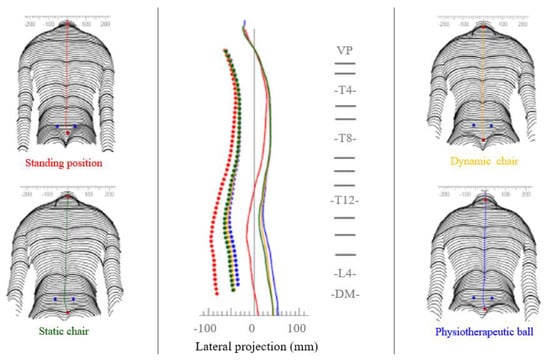
Figure 12.
Comparison of the spine curvature during sitting on various types of chairs and in the standing position.
4. Discussion
Compared with the standing position, the measurement results show that a considerable flattening process of the lower back lordosis develops in the sitting position (Figure 13). However, this flattening is biomechanically natural. A more significant finding of the measurements is the more significant flattening of the lower back spine during sitting on a dynamic chair compared with a static chair. The angle of the lower back lordosis of 19.7° was measured during sitting on a static chair and 17.6° on a dynamic chair—it is a reduction of curvature by 40.5% compared with the natural curvature in the standing position. Based on these measurements, we can present the following assumptions:
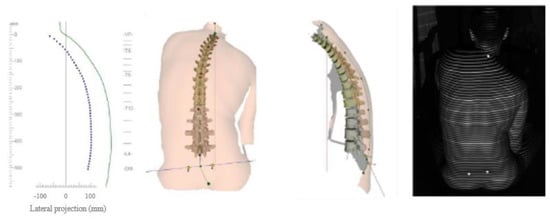
Figure 13.
Sitting position on a dynamic chair without involvement of the back muscles.
- The dynamic chair provides specific dynamics of sitting.
- The suitability of the dynamic chair for long-term utilization is to be verified by further research and measurements. In order to find out which border position the employee can achieve on a particular type of dynamic chair, the volunteer was asked to sit on the chair with the least possible involvement of the back muscles. The result of such a sitting position are shown in Figure 10. It is necessary to say that the depicted position represents an extreme situation, and from the biomechanical point of view, the employee would not be able to maintain this position for a long time. However, this position illustrates the freedom of the ball joint and which positions can develop.
- The dynamic chair enables different sitting positions in relation to the body posture. As the measurement results show, the curvature of the lower back spine was lower during sitting on a dynamic chair compared with the static chair. However, it is necessary to say the spine curvature shows a high variability regarding the used chair and therefore, it is probable that when testing another type of dynamic chair, the result could be different. However, the dynamic chair cannot be assessed only based on the spine curvature; the involvement of the postural muscles for keeping the correct body posture is an important aspect. It is connected mainly with the moveable seat and the physiotherapeutic ball. Until now, the authors have not included this fact in their research.
- Up to a certain degree, the dynamic chair reduces the static load. A larger group of muscles is activated during sitting on a dynamic chair than during sitting on a static chair. However, there is an assumption that in long-term sitting on this type of chair, the phasic and postural muscles can be overloaded. This idea is to be verified by further research.
5. Conclusions
The current human population ceases to move at work but also outside their workplaces. The results of such a lifestyle has been known for decades; for example, obesity, cardiovascular disease, and body posture disorders. The number of occupations requiring the sitting position as the main posture is growing due to the implementation of technologies simplifying and accelerating the working process. From the point of view of sitting-position jobs, the working chair is the most crucial element. The long-term sitting position increases the static load of the organism. A reduction in the static load can be achieved by utilizing a dynamic chair. The research results in this article cannot be considered definite, but they underline the fact that just a dynamic chair brings several risks and is no compact solution for dynamizing the sedentary jobs. The subsequent research in the area of sedentary jobs and simultaneously a new task for ergonomics could be the development of a dynamic workplace that would be autonomously adjusted to its users without their intervention and based on pre-defined time intervals. This would ensure an active change of the working position. This controlled dynamization of the sitting position could reduce the disorders and health problems caused by sedentary jobs.
Author Contributions
All authors contributed equally to the research presented in this paper and to the preparation of the final manuscript. All authors have read and agreed to the published version of the manuscript.
Funding
Slovak Research and Development Agency under Grant APVV-19-0305.
Institutional Review Board Statement
Not applicable.
Informed Consent Statement
Informed consent was obtained from all subjects involved in the study.
Acknowledgments
This work was supported by the Slovak Research and Development Agency under Grant APVV-19-0305.
Conflicts of Interest
The authors declare no conflict of interest.
References
- Moretti, A.; Menna, F.; Aulicino, M.; Paoletta, M.; Liguori, S.; Iolascon, G. Characterisation of home working population during COVID-19 emergency: A cross-sectional analysis. Int. J. Environ. Res. Public Health 2020, 17, 6284. [Google Scholar] [CrossRef] [PubMed]
- Ganesan, A.N.; Louise, J.; Horsfall, M.; Bilsborough, S.A.; Hendriks, J.; McGavigan, A.D.; Selvanayagam, J.B.; Chew, D.P. International mobile-health intervention on physical activity, sitting, and weight: The stepathlon cardiovascular health study. J. Am. Coll. Cardiol. 2016, 67, 2453–2463. [Google Scholar] [CrossRef] [PubMed]
- Vahdani, M.; Gholami, A.; Vahdani, H.; Mazaherinezhad, A.; Shaw, I. Rheumatic and musculoskeletal diseases among office workers: A narrative review. J. Pain Manag. 2020, 13, 9–13. [Google Scholar] [CrossRef]
- Horvathova, B.; Dulina, L.; Bigosova, E.; Barbusova, M. Analysis of Ergonomic Work Equipment Lowering the Static Load Based on Trend of Development of Work Activities, Multidisciplinary Aspects of Production Engineering; Wydawnictwo Panova: Zabrze, Poland, 2019. [Google Scholar]
- Bertrand, S.; Skalli, W.; Delacherie, L.; Bonneau, D.; Kalifa, G.; Mitton, D. External and internal geometry of European adults. Ergonomics 2006, 49, 1547–1564. [Google Scholar] [CrossRef] [PubMed]
- Brusaca, L.A.; Barbieri, D.F.; Beltrame, T.; Milan-Mattos, J.C.; Catai, A.M.; Oliveira, A.B. Cardiac autonomic responses to different tasks in office workers with access to a sit-stand table—A study in real work setting. Ergonomics 2021, 64, 354–365. [Google Scholar] [CrossRef]
- Gola, A. Design and management of manufacturing systems. Appl. Sci. 2021, 11, 2216. [Google Scholar] [CrossRef]
- Danilczuk, W.; Gola, A. Computer aided material demand planning using ERP systems and Business Intelligence Technology. Appl. Comput. Sci. 2020, 16, 42–55. [Google Scholar] [CrossRef]
- Haughie, L.J.; Fiebert, I.M.; Roach, K.E. Relationship of forward head posture and cervical backward bending to neck pain. J. Man. Manip. Ther. 2013, 3, 91–97. [Google Scholar] [CrossRef]
- Park, J.H.; Srinivasan, D. The effects of prolonged sitting, standing, and an alternating sit-stand pattern on trunk mechanical stiffness, trunk muscle activation and low back discomfort. Ergonomics 2021. [Google Scholar] [CrossRef] [PubMed]
- Meijer, E.M.; Frings-Dresen, M.H.W.; Sluiter, J.K. Effects of office innovation on office workers’ health and performance. Ergonomics 2011, 52, 1027–1038. [Google Scholar] [CrossRef] [PubMed]
- Schellewald, V.; Kleinert, J.; Ellegast, R. Effects of two types of dynamic office workstations (DOWs) used at two intensities on cognitive performance and office work in tasks with various complexity. Ergonomics 2020. [Google Scholar] [CrossRef]
- Grooten, W.J.; Äng, B.O.; Hagströmer, M.; Conradsson, D.; Nero, H.; Franzén, E. Does a dynamic chair increase office workers’ movement?—Results from a combined laboratory and field study. Appl. Ergon. 2017, 60, 1–11. [Google Scholar] [CrossRef]
- Chowańska, J.; Kotwicki, T.; Rosadziński, K. Comparison of standing and sitting position used in surface topography trunk assessment. Postępy Nauk Medycznych 2012, XXV, 476–483. [Google Scholar]
- Baumgartner, D.; Zemp, R.; List, R.; Stoop, M.; Naxera, J.; Elsig, J.P.; Lorenzetti, S. The spinal curvature of three different sitting positions analysed in an open MRI scanner. Sci. World J. 2012, 2012, 184016. [Google Scholar] [CrossRef] [PubMed]
- Truszczynska, A.; Drzal-Grabiec, J.; Cichosz, P.; Trzaskoma, Z. Measurement of spinal curvatures during sitting on a rehabilitation ball versus stool. Turk. Soc. Phys. Med. Rehabil. 2015, 62, 148–155. [Google Scholar] [CrossRef]
- Lengsfeld, M.; Frank, A.; van Deursen, D.L.; Griss, P. Lumbar spine curvature during office chair sitting. Med. Eng. Phys. 2000, 22, 665–669. [Google Scholar] [CrossRef]
- Nishida, N.; Izumiyama, T.; Asahi, R.; Iwanaga, H.; Yamagata, H.; Mihara, A.; Nakashima, D.; Imajo, Y.; Suzuki, H.; Funaba, M.; et al. Changes in the global spine alignment in the sitting position in an automobile. Spine J. 2020, 20, 614–620. [Google Scholar] [CrossRef]
- Masharawi, Y.; Haj, A.; Weisman, A. Lumbar axial rotation kinematics in an upright sitting and with forward bending positions in men with nonspecific chronic low back pain. Spine 2020, 45, E244–E251. [Google Scholar] [CrossRef]
- Ahn, S.; Kim, S.; Kang, S.; Jeon, H.; Kim, Y. Asymmetrical change in the pelvis and the spine during cross-legged sitting postures. J. Mech. Sci. Technol. 2013, 27, 3427–3432. [Google Scholar] [CrossRef]
- Gabajova, G.; Furmannova, B.; Medvecka, I.; Grznar, P.; Krajcovic, M.; Furmann, R. Virtual training application by use of augmented and virtual reality under university technology enhanced learning in Slovakia. Sustainability 2019, 11, 6677. [Google Scholar] [CrossRef]
- Grznar, P.; Gregor, M.; Krajcovic, M.; Mozol, S.; Schickerle, M.; Vavrik, V.; Durica, L.; Marschall, M.; Bielik, T. Modeling and simulation of processes in a factory of the future. Appl. Sci. 2020, 10, 4503. [Google Scholar] [CrossRef]
- Dulina, L.; Kramárová, M.; Czechova, I.; Więcek, D. Using modern ergonomics tools to measure changes in the levels of stress placed on the psychophysiological functions of a human during load manipulations. Adv. Intell. Syst. Comput. 2019, 835, 499–508. [Google Scholar] [CrossRef]
- Stefanik, A.; Grznar, P.; Micieta, B. Tools for continual process improvement—Simulation and benchmarking. In Proceedings of the 14th International Symposium of the Danube-Adria-Association-for-Automation-and-Manufacturing: Intelligent Manufacturing & Automation: Focus on Reconstruction and Development. 2003, pp. 443–444. Available online: https://bsm.fsre.sum.ba/Downloads/Pdfs/proceedings/proceedings_2004/052-BSM2004-Stefanik-Tools_for_Continual_Process_Improvement_-_Simulation_and_Benchmarking.pdf (accessed on 25 May 2021).
- Dijk, H.; Hööppener, P.F.; Siebenga, J.; Kragten, H.A. Medical photography: A reliable and objective method for documenting the results of reconstructive surgery of pectus excavatum. J. Vis. Commun. Med. 2011, 34, 14–21. [Google Scholar] [CrossRef] [PubMed]
- Wasim, M.; Saeed, F.; Aziz, A.; Siddiqui, A.A. Dotted raster-stereography. In Advanced Methodologies and Technologies in Artificial Intelligence, Computer Simulation, and Human-Computer Interaction; Khosrow-Pour, D.B.A.M., Ed.; IGI Global: Hershey, PA, USA, 2019; pp. 93–109. [Google Scholar]
- Roman, I.; Luyten, M.; Croonenborghs, H.; Lason, G.; Peeters, L.; Byttebier, G.; Comhaire, F. Relating the Diers formetric measurements with the subjective severity of acute and chronic low back pain. Med Hypotheses 2019, 133, 109390. [Google Scholar] [CrossRef] [PubMed]
- Rosemedical, Diers Leg Axis. Available online: https://www.rosamedical.ru/catalog/ortopedichescoe-oborudovanie-diers-263/diers-leg-axis-diers-international-gmbh-germaniya.html?fbclid=IwAR0xnckqv3soR_87p8lmhrfqyNuyP2Crubb6fxkpoI-LysNapN_uRnFmpe8 (accessed on 6 May 2021).
- Liu, X.; Yang, X.S.; Wang, L.; Yu, M.; Liu, X.G.; Liu, Z.J. Usefulness of a combined approach of DIERS Formetric 4D® and QUINTIC gait analysis system to evaluate the clinical effects of different spinal diseases on spinal-pelvic-lower limb motor function. J. Orthop. Sci. 2020, 25, 576–581. [Google Scholar] [CrossRef] [PubMed]
- DIERS Biomedical Solutions. Available online: https://diers.eu/en/products/spine-posture-analysis/diers-formetric-4d/ (accessed on 9 February 2021).
- DIERS Statico 3D. Available online: https://diers.eu/en/products/spine-posture-analysis/diers-statico-3d/ (accessed on 2 February 2021).
- Decree of the Ministry of Health of the Slovak Republic No. 542/2007 of 16th August 2007 on Details of Health Protection against Physical Stress at Work, Mental Workload and Sensory Stress at Work. 2007. Available online: https://www.ilo.org/dyn/natlex/natlex4.detail?p_lang=en&p_isn=84281&p_country=SVK&p_count=346&p_classification=14&p_classcount=54 (accessed on 25 May 2021).
- Synnott, A.; Dankaerts, W.; Seghers, J.; Purtill, H.; O’Sullivan, K. The effect of a dynamic chair on seated energy expenditure. Ergonomics 2017, 60, 1384–1392. [Google Scholar] [CrossRef]
- Roossien, C.C.; Stegeng, J.; Hodselmans, A.P.; Spook, S.M.; Koolhaas, W.; Brouwer, S.; Verkerkea, G.J.; Reneman, M.F. Can a smart chair improve the sitting behavior of office workers. Appl. Ergon. 2017, 65, 355–361. [Google Scholar] [CrossRef]
- Triglav, J.; Howe, E.; Cheema, J.; Dube, B.; Fenske, M.J.; Strzalkowski, N.; Bent, L. Physiological and cognitive measures during prolonged sitting: Comparisons between a standard and multi-axial office chair. Appl. Ergon. 2019, 78, 178–183. [Google Scholar] [CrossRef] [PubMed]
- Bučková, M.; Gašo, M.; Pekarčíková, M. Reverse logistic. In InvEnt 2020: Industrial Engineering-Invention for Enterprise [Electronic]. Bielsko-Biała: Wydawnictwo Akademii Techniczno-Humanistycznej; Wydawnictwo Akademii Techniczno-Humanistycznej: Bielsko-Biała, Poland, 2020; pp. 36–39. ISBN 978-83-66249-48-6. Available online: https://www.priemyselneinzinierstvo.sk/wpcontent/uploads/2020/10/InvEnt-2020-Proceedings-web.pdf (accessed on 2 February 2021).
- Schröder, J.; Stiller, T.; Mattes, K. Referenzdaten in der Wirbelsäulenformanalyse. Manuelle Medizin 2011, 49, 161–166. [Google Scholar] [CrossRef]
Publisher’s Note: MDPI stays neutral with regard to jurisdictional claims in published maps and institutional affiliations. |
© 2021 by the authors. Licensee MDPI, Basel, Switzerland. This article is an open access article distributed under the terms and conditions of the Creative Commons Attribution (CC BY) license (https://creativecommons.org/licenses/by/4.0/).